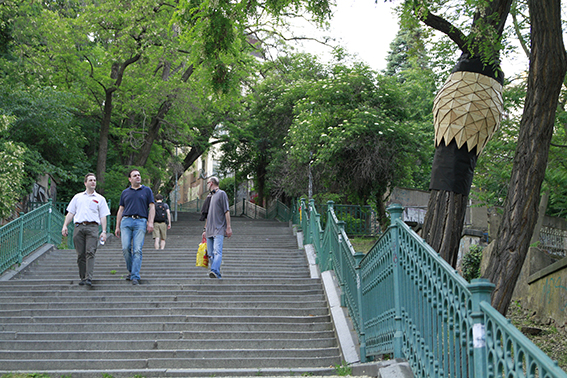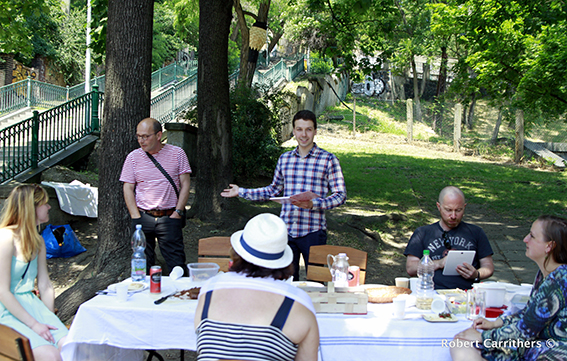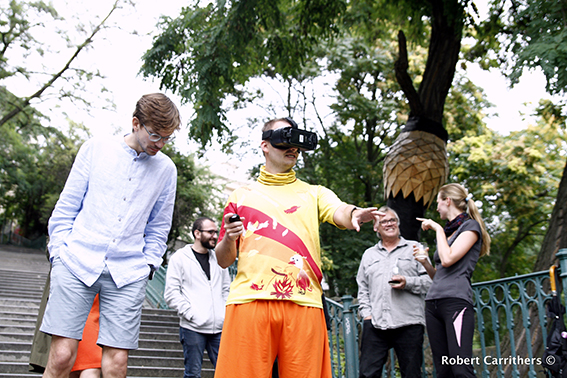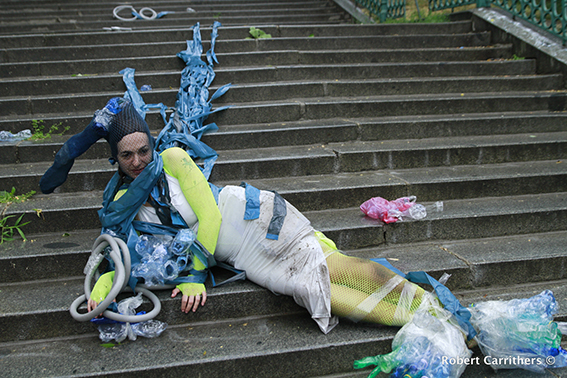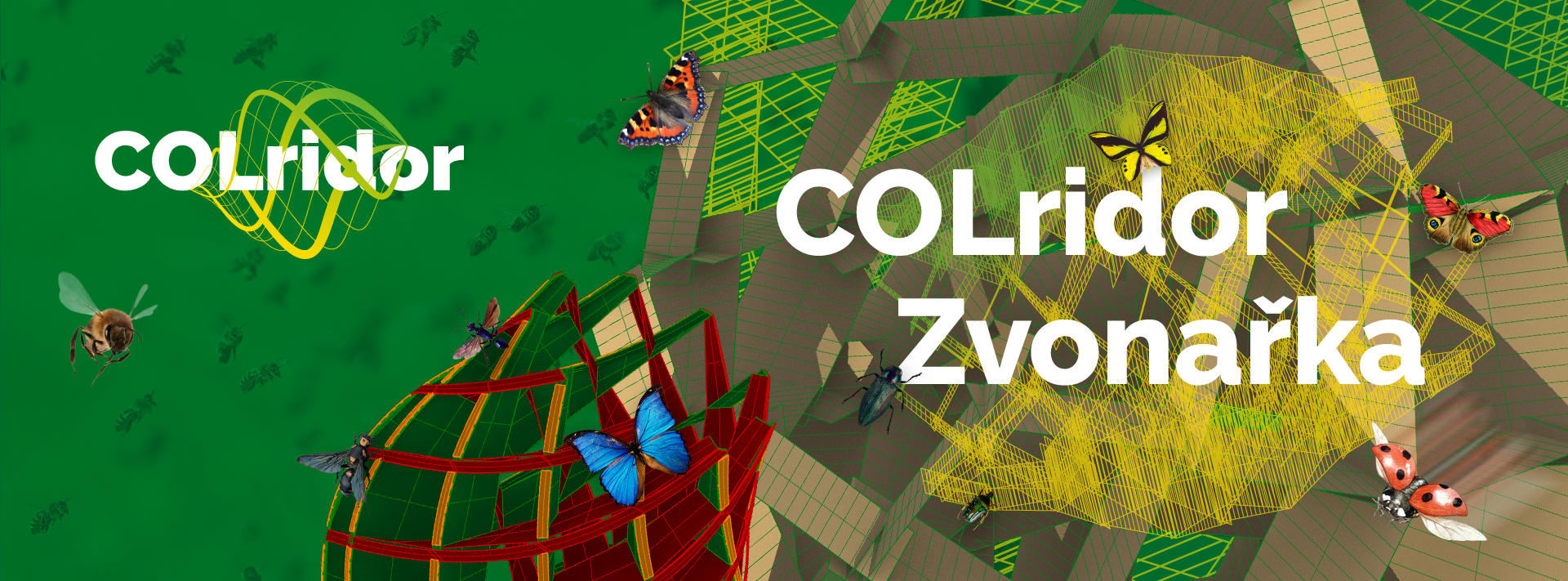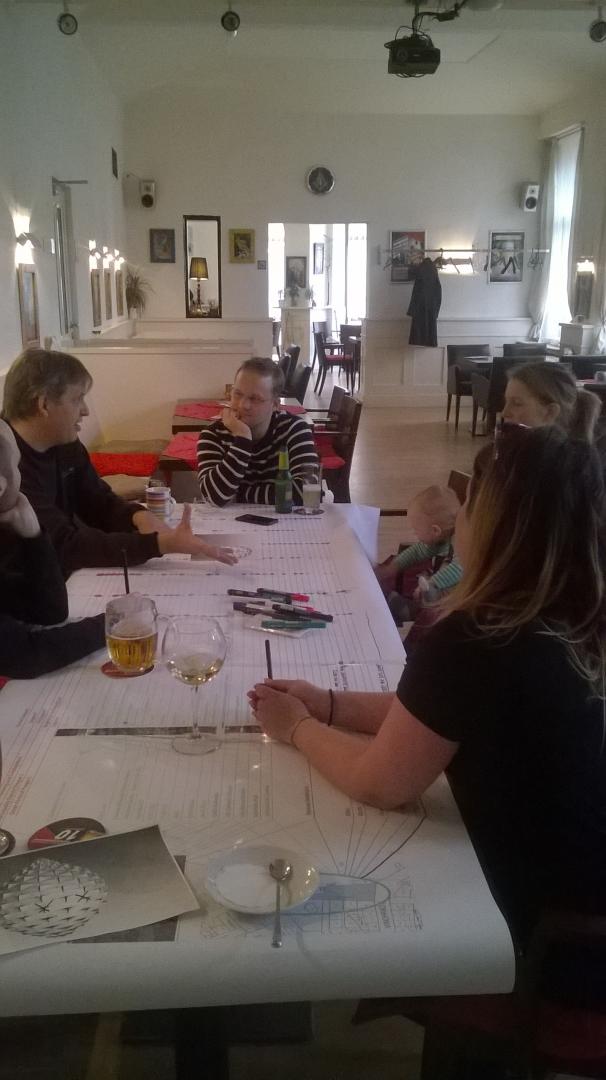COLridor
Basic information
Project Title
Full project title
Category
Project Description
COLridor is a community-based project that is to support a biocorridor in Prague city centre. The project is connecting the newest advancements in science with citizen codesign activities. The highlight of the project is an installation of an insect hotel, TreeHugger. TreeHugger is specifically designed to increase insects' biodiversity through the use of material science and serves as a restaurant for bats and birds. It is marked with a QR code leading to its DIY recipe for its dissemination.
Project Region
EU Programme or fund
Description of the project
Summary
The project was initiated in order to support Prague central biocorridor and to increase public awareness of its existence. It was codesigned with the local community and a transdisciplinary team of experts. Several interventions in a form of objects, mobile applications for virtual (VR) and augmented reality (AR) and events were cocreated. The project's highlight was an advanced insect hotel, TreeHugger. TreeHugger is designed to support local biodiversity by offering a variety of climatic chambers thanks to the temperature and humidity responsiveness of solid wood. Wood panels cut in a tangential section are warping when the humidity evaporates. The intensity of this feature is dependent on where in the tree trunk was the panel originally placed. Therefore, using the mixture of positions, the insect hotel generates different climates in different chambers. Therefore, a larger variety of species with different climatic preferences will find their habitats. This performance is even increased by algae growth on the structure. As algae sorp moisture, the wood warps more in hot and dry weather and does not warp in the opposite direction when the humidity is high and the temperature low. As the territory of the algae is on the north orientation, larger diversity is achieved. This fact is also supported by the design of the hotel. Its round shape is oriented towards all word axes, therefore provides opportunities for different insects species preferences. TreeHugger is not only a hotel. It is also a restaurant for bats and birds passing the biocorridor. A DIY recipe was placed on our blog (see Systemic Approach to Architectural Performance blog link) for the public to reproduce the TreeHugger insect hotel and a QR code leading to the link was engraved into it. Therefore, this urban intervention is generative. Public events, such as honey blooming plants seed bombing, were arranged to support the food web.
Key objectives for sustainability
The project's objective was to generate an edible and habitable landscape on biocorridor leading through the city centre of Prague. It was also crucial that the public gets engaged in order to understand and support local biodiversity and maintain the resilience and generativity of the project through DIY.
An edible and habitable landscape was created through the TreeHugger insect hotel and bats and bird restaurant and through several seed bombing events. The honey blooming plants then became a restaurant for insects.
Social sustainability was secured in these steps:
1. The overall project was codesigned with the local community. Therefore, community ownership was created. This supports local pride as well as prevents vandalism.
2. Collective fabrication and placement of the TreeHugger. A QR code leading to the insect hotel's DIY recipe was placed.
3. Multi-genre EnviroCity festival that was to celebrate and disseminate the information about the newly created biotop. The festival involved several disciplines and professions, such as bird and bats monitoring and seed bombing with ecologists, environmental humanities experts talks, local politicians discussions, dance and art performance, VR and AR mobile applications, environmental design, systemic design and architectural history lectures, etc.
4. Participation in community events was to increase the local dissemination. We participated in Prague's most popular public festival 'Experience the City other Way'. As this festival is taking place in the autumn, we were teaching children how to create food mixtures for birds. Our stand was directly located under the TreeHugger and the DIY recipe got better disseminated.
5. Participation in makers' events. We were targeting the makers not only through online publishing but we also joined Prague Maker Faire. At this event, we had a lecture and a stand. Our stand was offering opportunities for seed bombing mix and was promoting the QR code for the TreeHugger recipe.
Key objectives for aesthetics and quality
Producing beautiful design and a pleasant experience was a key point for us. Beautiful design generates also a pleasant experience and helps to avoid vandalism. Though codesigning with the local community, the experts' team covered professional designers, architects, landscape architect and graphic designer. The international performers, artists and experts were selected as the most advanced in their field and had a high standard of aesthetic quality goals. As a result of such a transdisciplinary team, the outputs had synergised high standard design of graphics, objects, events, and mobile applications. The parametric design was used for the TreeHugger design which benefited from the digital tool Grasshopper. This tool enables advanced geometries of the design and its digital fabrication. The goal of the design of the object was aimed at blending with nature and representing a synergy with it. The shape of the Treehugger and its parametric structure inspired the graphical branding of the project and the festival, such as logos, banners, posters, etc. (see links to the blog and social media). All events such as art and dance performances, lectures, workshops, applications, etc. were relating to the TreeHugger by their content and visual design (see the reports at the Systemic Approach to Architectural Performance blog). This generated a special atmosphere and synergy across various elements of the project and the local environment. The branding, as well as the designs, were synergising nature and technology to show the vision of the Post-Anthropocene when people and other species can live together in synergy. This was also supported by various events that were blurring nature and technology by their form and content (see reports at the Systemic Approach to Architectural Performance blog).
Key objectives for inclusion
Social and other species inclusion was a crucial part of the project. Sometimes, the situation was a bit difficult as the locality is placed on the border of an expensive and deprived area. Therefore, inviting everyone to one dining table was one of our achieved targets. The project was aiming at the support of community togetherness in several points:
1. The project was codesigned with the local community across a variety of social groups, including the deprived parts of it. When generating community ownership across different, sometimes conflicting, social groups, social sustainability is achieved.
2. The project was designed to generate community pride, understanding and support of the importance of the location in terms of biodiversity. It generated the attachment to the locality by understanding its importance in terms of biodiversity and by participation in supporting it.
3. The EnviroCity festival was multi-genre, therefore targeting a variety of social groups: children, young, elderly, productive age, variety of education and professions, including deprived parts of the community, etc. The festival covered all refreshments which were mainly appreciated by low and no income parts of the community as there was no social difference when dining together. The people got aware of how to mix bird food from what people typically have in the kitchen, how to make a seed bomb or how to reproduce an insect hotel. It was also discussed how to keep the neighbourhood tidy and how to protect honey blooming plants. Much of this does not require any or large investment.
4. Accessing other events with a broader audience increased public awareness and engaged people in joining the project. The people got aware of how to mix bird food from what people typically have in the kitchen, how to make a seed bomb or how to reproduce an insect hotel.
5.Everyone with an internet connection can participate in reproducing the recipes for the interventions from the blog.
Results in relation to category
This project is showing how the built environment may contribute to the protection of nature and biodiversity, taking into account cultural and social needs:
1. It is increasing biodiversity in a densely built-up area of central Prague and increasing the biodiversity connectivity across several neighbourhood parks' habitats that are rich in bats and birds. Such connectivity in a dense urban environment is critical as the species migrating from a biotop to a biotop might die of exhaustion if they do not find a spot to eat and rest. This was exactly the point missing on the map for larger biodiverse connectivity.
2. The project has been also addressing cultural and social needs by associated events that were to generate knowledge and awareness of urban biodiversity across generations and genres interests. This is specifically important as the public supports its local biodiversity, therefore the project is socially sustainable. Bats, birds and insect mapping events were created as well as the seed bombing and honey blooming plants checking events. Various VR and AR mapping applications were also provided with the tools and explanations of their use. All artists and expert's events had biodiversity as their main topic. The TreeHugger itself supports makers culture by providing DIY recipes.
3. The TreeHugger insect hotel urban intervention has, however, further mission. It serves as a first prototype on how building envelopes can serve to increase biodiversity in densely built-up neighbourhoods. It generated good enough data that are now used in the research for its implementation in the building industry. The envelope is to be used in a variety of scales, generating insects', birds' and bats' habitats. Such architectural adaptations are specifically important in dense urban neighbourhoods where wroten wood is removed, lofts are adapted for human apartments, trees do not manage to absorb the CO2 produced by cars and meadows mowed.
How Citizens benefit
The project increased the local pride of the community and glued it together through cocreation and events:
1. For the codesign part, a specific Systems Oriented Design tools, the mini- and gigamapping, were used. These tools enable a synergy across the stakeholders as they are specific tools for a multi-centred perspective. The stakeholders first individually map their own universe in relation to the project, the minimap. This is presented to all team. Then, they start searching for relations across each other's universes, generating the gigamap. Such a process generates empathy and understanding across the stakeholders. It is, therefore, easier to find synergy and develop one synergetic design when different community representatives and experts representing other species are in harmony.
2. With the QR code on the TreeHugger, everyone can also reproduce this and other projects by creating their local specific adaptations. This is enabled by parametric design when whoever can adapt the parameters.
3. The project supported the local awareness of the importance of urban biodiversity and the role of the selected locality in it. The project also made the local living environment more beautiful and educated people on how to support urban biodiversity and why they should do that. Thanks to the several discussion and action events with invited experts, many myths (i.e. about feeding and infections) were disproved.
4. Because the community was/still is able to participate in the project, the people feel its ownership and the ownership of its mission. For example, when the town hall with bad relation to urban biodiversity decided to remove the trees along the Nusle Stairs, the city hall would never remove the TreeHugger. Such action would generate a large local protest. Therefore, the tree carrying the TreeHugger was preserved. With the increase of similar actions, more of the urban biodiversity can be preserved and even increased.
Innovative character
The project is innovative in several ways:
1. This project is a representation of systemic design with multi-centred perspectives. It is therefore using the most advanced methodologies for cocreation, such as mini- and gigamapping. The project is blending cocreation by the local community and contemporary researchers in material science, dendrology, urban ecology and ecological architecture, urban design and sociology.
2. The project is synergising technology with different digital design tools and nature with the vision of the Post-Anthropocene era when humans and non-humans live together in harmony. The project is using digital design technologies such as AR, VR and parametric design for enabling customised local specific adaptations to local nature that can be approached by the community members.
3. In this project, it is the first time that responsive wood research was applied into practice for generating any habitats, specifically non-human ones. By now, all other realisations in the field were created in the form of exhibition pavilions or exhibition objects showing the responsiveness of the wood barely suggesting any application in practice. None of those exhibits was meant to support biodiversity or anyhow applied in practice through realisation. This project is informing the research on how responsive wood can take part in cross-species coliving in an urban environment.
4. The project is also the first application, where the algae were used to support the responsiveness of the wood (other prototypes testing this were created only by the author). This is specifically important as the algae are also reducing urban CO2.
5. The project is also using a tree as a structural design. There has been some research done in this field by BAUBOTANICS group at the Technical University of Munich. However, this research is not generating non-human habitats in an urban environment (except the trees themselves) and does not anyhow interact with local communities.

